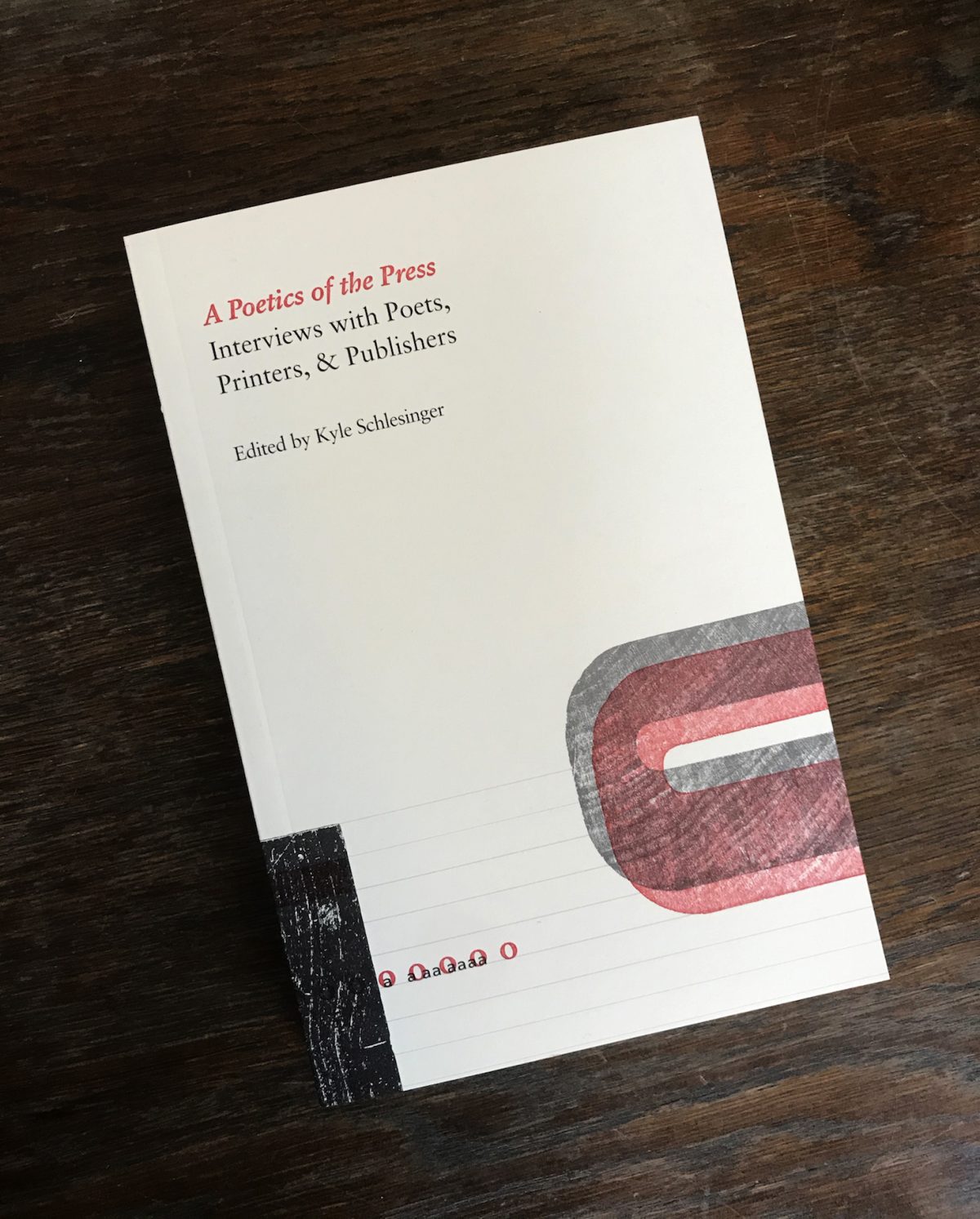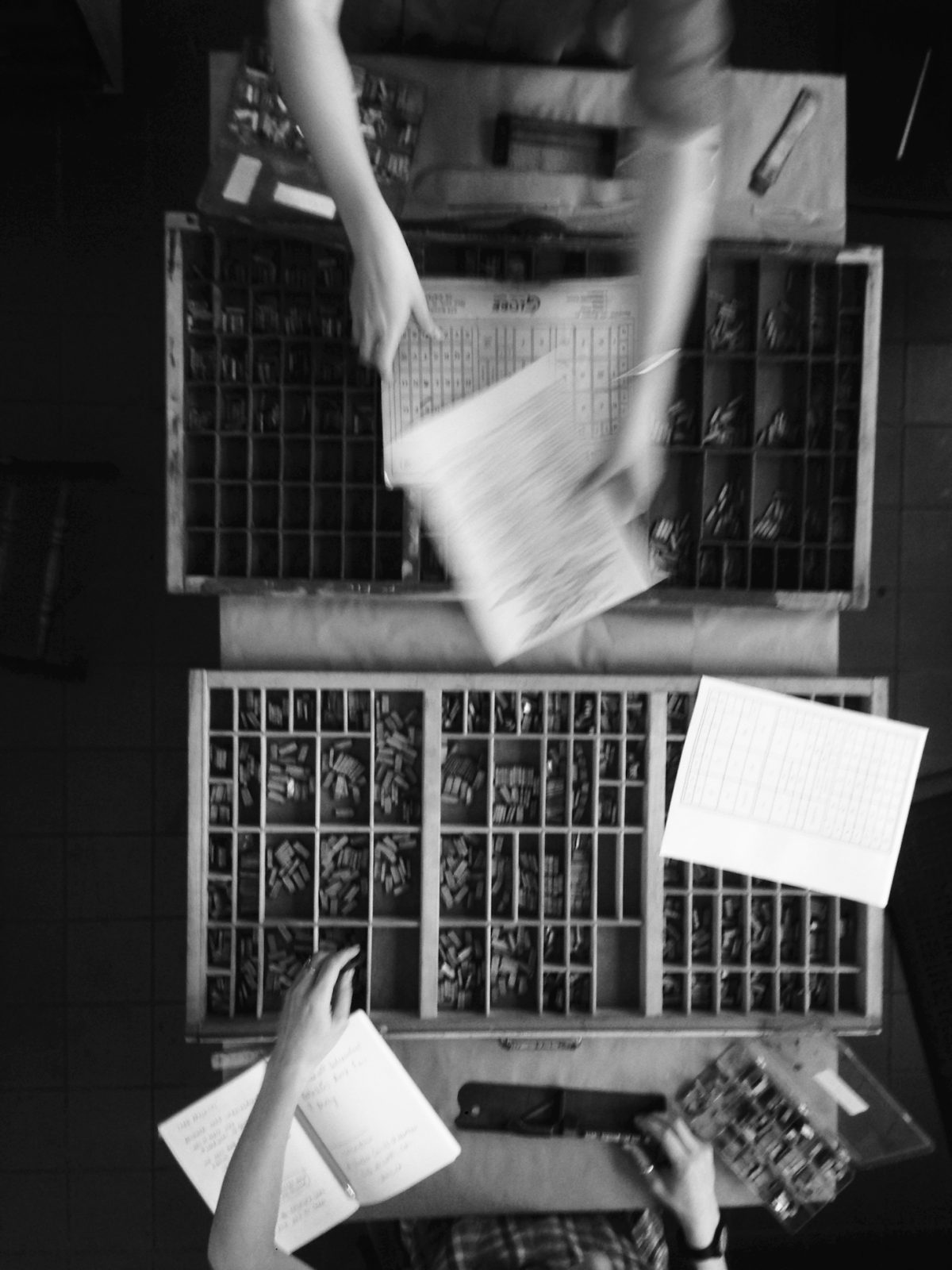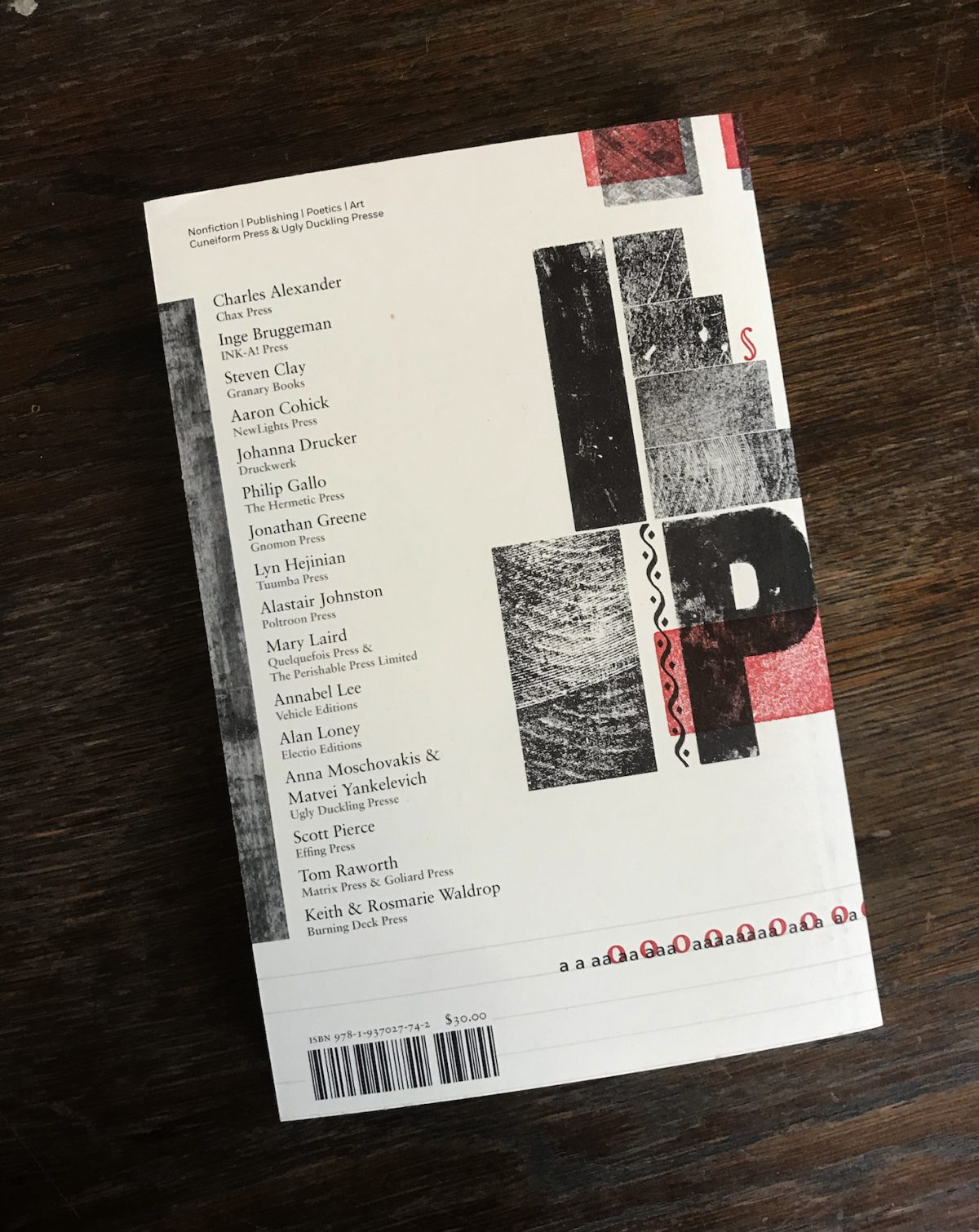

Kyle Schlesinger’s A Poetics of the Press: Interviews with Poets, Printers, & Publishers offers a window into the fears and aspirations of many giants of the industry. As a collection of personal narratives and insights, it opens the door to further study into the expanding field of hand-printed books, artist books, and all that falls in between.
The book’s 16 interviews spotlight poetry presses as it interacts with the “art of the book and their personal approaches to publishing,” according to Schlesinger’s introduction. Spanning over four decades of publishing activity and over a decade of interviews (2005–18), it focuses on the small press literary boom that began in the early 1960s, documented by publications like Granary Books’s A Secret Location. (Two of the presses in A Poetics of the Press — Vehicle Editions and Tuumba Press — are covered in A Secret Location.)
As Schlesinger writes, Granary founder Steven Clay was a large impetus for this interview series and was his first subject:
I was researching the relationship between poetry, typography, and visual art in books printed by hand in America between the end of the Second World War and the end of the Vietnam War. At that time I realized that there were [sic] a dearth of publications on the subject, and that Clay’s Granary Books had published much of the literature I found most compelling.
In addition to Clay, Schlesinger talks to numerous influential figures in the field, including Johanna Drucker and duo Keith and Rosmarie Waldrop, to name a few. Many of the interviews focus on histories — for instance, how books were made and by whom. This is the case with Tom Raworth (Matrix Press & Goliard Press), Drucker (Druckwerk), and Scott Pierce (Effing Press). Much of the back and forth between Schlesinger and the interviewees is a who’s who of publishing activities, types of machines, and printing techniques. For those intimately involved in this community, these notes read like gossip columns or footnotes to beloved titles. Despite Drucker’s own extensive writing on the field of artistic publishing, her interview is more of an expanded version of her curriculum vitae, in which she details her career shift “from media studies and literature to information studies and history of the book.”
Among other practical topics that recur in the interviews are ones of funding and book prices. Annabel Lee, of Vehicle Editions and formerly secretary/treasurer of the Center for Book Arts in New York, and Lyn Hejinian, of Tuumba Press, both note small press grants from the National Endowment for the Arts, which are no longer available.

More interesting than how the projects were funded — which is important to making the realities of artistic publishing more transparent — is the question of how monetary value impacts cultural and conceptual value, in addition to materials. Across nearly all the interviews, publishers explained the effects of making expensive handmade books versus commercially produced books that could be sold more affordably. Ugly Duckling Presse, which published this volume, had a model (at the time of the interview in 2008) of keeping prices low “just to insist that the value of literature, poetry, and translation that we publish isn’t really determined by market forces.” As a member of the collective editorial team, Matvei Yankelevich explained, “value has been part of our experiment from the outset — an attempt to prove the lack of value that culture attaches to the kind of poetry that we publish.”
In terms of materials choices, Hejinian’s “decision to staple the chapbooks together was intended to undermine the commodity value of them.” She adds, “I wanted to emphasize immediacy rather than preciousness or permanence of the texts.” For some, the material choices made the book seem less accessible; Clay notes, “the perception of letterpress as being elitist, in a way, necessarily made the books more expensive than they would have been if they were printed in any other way.”
With increased price looms the danger of “the fetish object,” the book as an art object that no one reads or holds. This fear was articulated by many of the publishers, including Ugly Duckling, but perhaps said best by the earliest publishing duo included in the book, Keith and Rosmarie Waldrop, who founded Burning Deck Press in 1961. “Collectors of fine printing were likely not reading the text,” according to Rosmarie. “It was a factor in our decision for Burning Deck not to aim at books that would be kept on closed shelves.” Hejinian similarly asserted, “The works are not here to be pretty, they are here to be read.”
For someone like myself, who writes critically on artists’ publishing, the moments when Schlesinger pushes his subject to define a landscape of book arts and artist books (and at times makes his own feelings on the subject clear) are the most interesting. Clay lays bare the core of the unending debate of the democratic multiple versus the limited-edition artist book in the context of the early days of Granary Books and the founding of renowned New York art book store Printed Matter:
In my mind, [Clive Phillpot] was also a key polemicist, in some ways creating a divide between the [Edward] Ruscha model (a purist, conceptualist, cheap democratic multiple) of the artists book as exemplary — almost to the exclusion of everything else.
Phillpot, former art librarian at MoMA and one of the pioneers of writing about artist books, was involved in the early days of Printed Matter, which was founded as a distributor for affordable artist books. Granary and small other presses a the time were more devoted to the craft of publishing more expensive artist books as multiples. While much of this debate has been stated in numerous other books, coming across these slices of insight into different publishers’ reasoning for their positions makes clear a shared concern: making books that won’t be read.

In this context, the divide between unique and multiple, precious and affordable, craft and concept, becomes deeply rooted in the notion of how books are read, and whether the divide between book craft and the crusade of the democratic multiple can be bridged. “Could you cross over to the other in a meaningful way? Or would each be lost? Are there differences so powerful that the two could never converge harmoniously?” Clay asks. In a 2016 interview, INK-A! Press founder Inge Bruggeman shared a similar sentiment and cited research on the subject by former director of the Minnesota Center for Book Arts, Betty Bright.
Schlesinger also has his own press, Cuneiform, started in 2000. Many of the names in this collection appear in the catalogue of Cuneiform books, demonstrating the depth of his knowledge and interest in this particular milieu. The landscape of publishers who use letterpress today, in addition to other innovative printing techniques, continues to expand. The next primary source book may collect accounts from creators like letterpress artists Tia Blassingame (Primrose Press) and Ben Blount; those working in urgent publishing evocative of the mimeograph revolution, such as Paul Soulellis (Queer.Archive.Work) and Be Oakley (GenderFail); and zine publishers like Yusuf Hassan (BlackMass Publishing), who expands the possibilities of books made with affordable techniques, like a photocopier.
Poetics of the Press illustrates how invaluable firsthand accounts are to historicize a moment and medium. Many of the interview subjects eagerly looked to the future of the book as technology redefines what is possible, affordable, and innovative. With several of the interviews conducted over a decade ago, I wonder what reaction the subjects will have as they revisit their optimism (or, in a few cases, pessimism) about hand-printed books and the future of publishing. I hope this book is one of many to come in a growing history told by makers who take on the challenge of being publishers.
A Poetics of the Press: Interviews with Poets, Printers, & Publishers by Kyle Schlesinger (2021) is published by Ugly Duckling Presse and is available online and in bookstores.
0 Commentaires